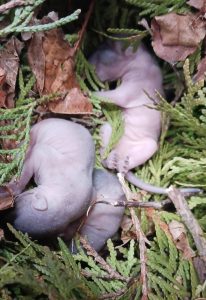Spring is the busiest time of year for wildlife control professionals at Oakville & Milton Humane Society and Skedaddle Humane Wildlife Control. As temperatures continue to rise, we’ll see an increase in the number of calls from residents experiencing a conflict with some of the many wildlife species that call this area home.
Here are some tips to prevent a wildlife infiltration at your home, courtesy of Skedaddle.
 The driving force behind increased wildlife conflict during spring is the arrival of babies. Raccoons, squirrels, skunks and birds begin having their babies in March and the birthing season continues well into the summer. During this time urban wildlife species seek out sheltered and secure den and nest sites to have and raise their babies. They often find their way into attics, chimneys, garages, decks and vents, leading to home damage and safety concerns.
The driving force behind increased wildlife conflict during spring is the arrival of babies. Raccoons, squirrels, skunks and birds begin having their babies in March and the birthing season continues well into the summer. During this time urban wildlife species seek out sheltered and secure den and nest sites to have and raise their babies. They often find their way into attics, chimneys, garages, decks and vents, leading to home damage and safety concerns.
Some of the most common calls we receive during spring are:
- Raccoons and squirrels damaging roofs to gain access to attics
- Skunks burrowing below decks, porches and sheds
- Starlings nesting inside openings for bathroom, kitchen and dryer vents
Wildlife removal becomes much more challenging when babies are involved and while it might be tempting to tackle a wildlife intrusion as a DIY project there are plenty of reasons you should leave it to an experienced professional. Wildlife babies are born with their eyes closed and are defenseless and immobile for weeks or even months after birth. When performing wildlife removals during spring it is important to keep mom and babies together. Unfortunately, each spring we see litters of babies that have been orphaned by someone that has unwittingly trapped and relocated their mother or patched up an entry point and locked babies inside an attic or chimney.
When mothers become separated from their babies it can lead to an inhumane outcome and added property damage. The key to a successful wildlife removal during the birthing season is having the right game plan for how to keep mother and babies together. That usually means climbing ladders and crawling through attics to find and remove, by hand, any immobile babies so that they can be reunited with their mother outside the home.
If you hear noises in your attic or see signs of wildlife damage to your home this spring your next step should be to contact a wildlife control professional. Before hiring anyone be sure to ask good questions about the techniques and strategies they intend to use and make sure they have a plan for how to deal with any babies that might be involved.
Help reduce your odds of a wildlife intrusion this spring by:
- Inspect the exterior of your home, as well as garages or sheds, for signs of damage that might have happened over winter – keep a close on your roof and foundation
- Repair loose siding or damaged shingles before they are discovered by opportunistic wildlife
- Trim tree branches that overhang your roof to make it harder for wildlife to gain access
- Clean out eavestroughs to prevent rotting that can create openings for wildlife
- Keep your property free of clutter that can be used for shelter
- Remove food sources and secure garbage until the morning of pick up
Who to call if you need help
OMHS' mandate includes caring for sick, injured and abandoned animals. In Oakville, if you believe an animal in Oakville is sick or injured, call OMHS Animal Protective Services at 905.845.1551
In the Town of Milton, please call 905-878-7252 ext. 2254, or email: bylaw@milton.ca
For the humane removal of unwanted house guests contact Skedaddle Humane Wildlife Control.
